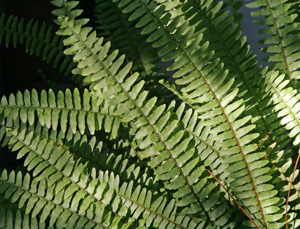
Boston fern is a common ornamental plant frequently grown as a houseplant in cold climates. The species Nephrolepis exaltata is a tropical species of sword fern (in the family Lomariopsidaceae), native to humid forests from northern South America through Mexico, in Florida and the West Indies where it can grow up to 7 feet tall. The plant called Boston fern – N. exaltata ‘Bostoniensis’ – is a natural variant of the species that was discovered in a large shipment of ferns sent from Philadelphia to Boston in 1894. This evergreen fern is hardy in zones 9-11, so can be grown outdoors in very mild climates but it adapts readily to container culture for use indoors or seasonally outdoors in other parts of the world.

Nephrolepis exaltata has broad fronds with alternate leaflets (pinnae) on either side of the midrib. The pale- to medium-green fronds can grow up to 4 feet long and 6 inches wide. There are two rows of round sori (clusters of spore-bearing organs; ferns are seedless vascular plants that produce spores instead of seeds) near the margins on the underside of the pinnae. Each leaflet is generally deltoid in shape, with slightly serrate, undulating edges. The species has erect fronds, while ‘Bostoniensis’ has gracefully arching fronds. The plants will also send out long, thin runners (stolons) which will root to form a new plant when they touch the ground.
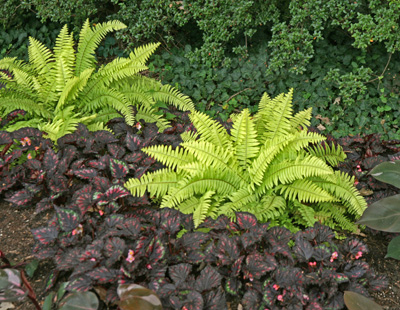
Use Boston fern indoors as a houseplant or as a seasonal accent plant outside once all danger of frost is past. These plants are ideal in hanging baskets, in raised containers, or on plant stands, so their long fronds can provide a dramatic arching fountain of foliage. They can also be grown in the ground as somewhat upright accents among low annuals such as impatiens or begonias, combined with shade-loving coleus, browallia, caladium and torenia, or as a tall tropical-looking ground cover. Combine potted Boston fern and other containers with colorful flowering annuals on decks or patios.
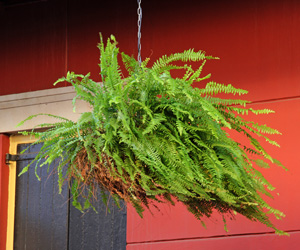
Boston fern is easily grown in hanging baskets or other containers where the long fronds can hang downward readily. Indoors position the plant in medium bright light, such as in an east facing window or behind a sheer curtain in south and west windows (or far enough from the window so the plant is not in direct sunlight). If growing outdoors, provide full or partial shade. Boston fern likes a night temperature of 65ºF and a warmer day temperature that does not exceed 95ºF, but will tolerate cooler temperatures if growing outside. If grown seasonally outdoors it should be moved inside or protected when temperatures dip into the low 40’s.

This plant does best in a well-drained but moisture-retaining soil or soilless potting medium (such as a mixture of peat and vermiculite). Although it does best with consistent moisture, it is the most drought tolerant of the commonly cultivated ferns. If possible, keep the potting medium evenly moist but not saturated. This can be a real challenge in hot weather outdoors, especially with smaller containers. Double potting – placing the fern in it pot in a second, larger container lined with moist sphagnum moss – will help retain moisture and humidity around the plant.
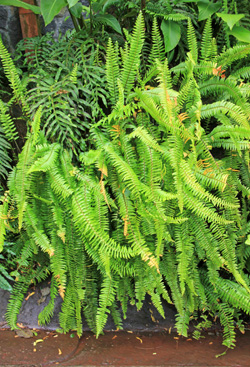
Boston fern does best in rich soil or with regular fertilization (liquid or slow release houseplant fertilizer at half strength) every 4-6 weeks when actively growing; the amount should be cut back a lot in winter. Over-fertilizing will result in browning and drying from the ends of the fronds. Ferns do best in humid environments, so it may suffer – the tips and edges of the pinnae may turn brown – in dry interiors, especially in the winter. Boston fern has few pests but scales and mealybugs can be a problem indoors and slugs may damage plants outdoors. The easiest way to deal with scale infestations is to cut off the affected fronds. Cutting old fronds off at the soil will help encourage growth of new fronds.
Although ferns can be propagated from spores, named cultivars will not come true, and most gardeners find it much easier to just divide the plants (commercial growers frequently propagate by tissue culture). Repot and/or divide every few years in the spring, cutting the root ball vertically with a sharp knife in half or quarters, keeping as many leaves as possible per division.
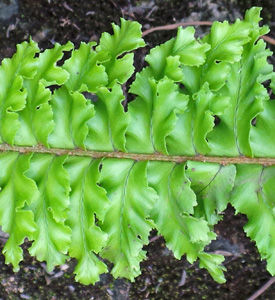
The species produces sports frequently which may or may not be stable. A number of cultivars of Nephrolepis exaltata are available besides ‘Bostoniensis’ including the following (but many others can be found):
- ‘Compacta’ is shorter, more compact and more upright than ‘Bostoniensis’ with 15-18” fronds.
- ‘Dallas’ is a small cultivar (also sold as ‘Dallas Jewel’) that spreads rapidly and tolerates lower light levels and less humidity.
- ‘Florida Ruffle’ is medium-sized, with twice divided leaflets for a more feathery look. The stiff fronds are wider at the base for a denser canopy.
- ‘Fluffy Duffy’ is small and fine-textured for a feathery look. The fronds are divided two or three times with extensive overlapping, to form a very dense plant.
- ‘Fluffy Ruffles’ is a smaller, sterile selection with stiff, upright fronds with dense wavy-edged and incised leaflets.
- ‘Golden Boston’ has yellow-green fronds.
- ‘Massii’ is very similar to ‘Bostoniensis’ but is darker green and more pendulous.
-
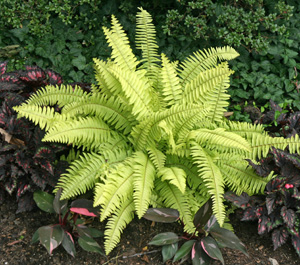
Rita’s Gold™
Rita’s Gold™ has more compact, chartreuse fronds. - ‘Rooseveltii’ has finely cut and feathery fronds, some with crested ends.
- ‘Verona’ is an heirloom variety with very drooping, lacy fronds.
- ‘Whitmanii’ has more finely cut and feathery fronds that tolerates lower humidity.
– Susan Mahr, University of Wisconsin – Madison





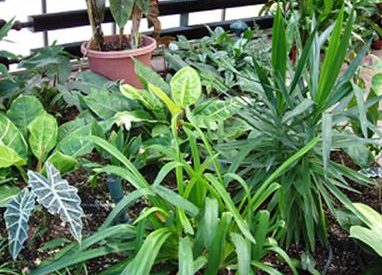 Houseplant Care
Houseplant Care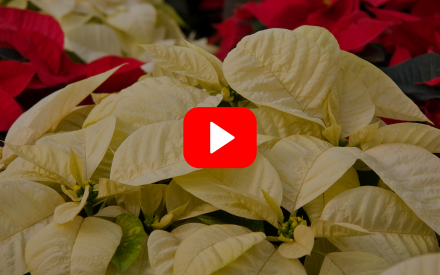 ▶ WATCH: Maintaining Your Festive Houseplants
▶ WATCH: Maintaining Your Festive Houseplants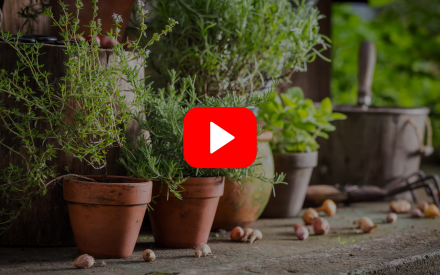 ▶ WATCH: Bringing the Garden Inside
▶ WATCH: Bringing the Garden Inside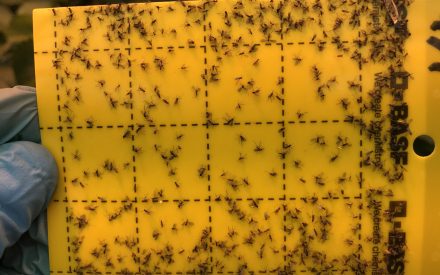 Fungus Gnats on Houseplants
Fungus Gnats on Houseplants


